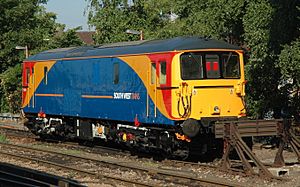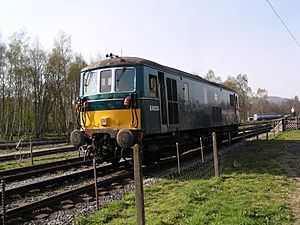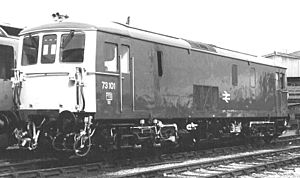British Rail Class 73 facts for kids
The British Rail Class 73 locomotives are special trains that can run in two ways! They are called electro-diesel because they can get power from electric rails or from a diesel engine. This makes them very useful because they can travel on tracks that have electricity and also on tracks that don't.
Quick facts for kids British Rail Class 73 |
|
 |
|
| Class 73, no. 73201 at Woking. This locomotive was used by South West Trains as a “Thunderbird” to rescue failed trains. | |
| Power type | Electro-diesel |
|---|---|
| Builder | 73/0: British Railways’ Eastleigh Works 73/1: English Electric at Vulcan Foundry |
| Build date | 1962, 1965–1967 |
| Total production | 49 |
| Configuration | Bo-Bo |
| UIC classification | Bo'Bo' |
| Gauge | 4 ft 8 1⁄2 in (1,435 mm) |
| Wheel diameter | 3 ft 4 in (1.016 m) |
| Length | 16.36 m (53 ft 8 in) |
| Locomotive weight | 73/0: 76.30 long tons (77.52 t) 73/1: 76.80 long tons (78.03 t) |
| Electric system(s) | 660–750 V DC |
| Current collection method | Third rail |
| Prime mover | English Electric 4SRKT Mk II |
| Traction motors | 73/0: EE 542A 73/1: EE 546/1B |
| Top speed | 73/0: 80 mph (129 km/h) 73/1: 90 mph (145 km/h) |
| Power output | Electric (continuous): 1,420 hp (1,059 kW) Electric (one-hour): 1,600 hp (1,193 kW) Engine: 600 hp (447 kW) |
| Tractive effort | 73/0 (electric): 42,000 lbf (186.8 kN) 73/0 (diesel): 34,100 lbf (151.7 kN) 71/0 (electric): 40,000 lbf (177.9 kN) 73/1 (diesel): 36,000 lbf (160.1 kN) |
| Train heating | Electric Train Heating |
| Train brakes | Vacuum, Air and Electro-Pneumatic |
| Career | British Rail Eurostar FM Rail Gatwick Express FirstGBRf Network Rail South West Trains |
| Number | E6001–E6049; later 73001–73006, 73101–73142 |
| Axle load class | Route availability 6 |

Contents
About the Class 73 Train
The Class 73 is a very special type of train called an electro-diesel locomotive. This means it can use two different ways to get power. It can run on electricity from a special third rail, or it can use its own diesel engine.
How it Works: Electric Power
When the Class 73 is on tracks with a third rail, it gets its power from there. This is a common way for trains to get electricity in some parts of Britain, especially in the south. Using electric power makes the train very strong and fast.
How it Works: Diesel Power
If the train needs to go on tracks that don't have electric power, it can switch to its diesel engine. This engine lets the train travel anywhere, even on lines that aren't electrified. However, the diesel engine isn't as powerful as the electric motor. This is why these trains usually stay on routes that have the third rail.
Why it's Unique
The Class 73 is the only train of its kind still running in Britain. Before 1977, there was another type of electro-diesel train, the Class 74. But after those were retired, the Class 73 became truly unique. Its ability to switch between electric and diesel power makes it very flexible for different railway lines.
Who Used These Trains?
Many different railway companies have used the Class 73 over the years. Some of them include:
These trains have been used for many jobs, from pulling passenger trains to rescuing other trains that have broken down.
Images for kids
-
A British Rail Class 73 with a parcels van and carriages under British Rail carrying the mail in 1986 through Clapham Junction.
-
Dover Western Docks Sidings in 1982 under British Rail.
-
No.E6006 in preservation at Bridgnorth on the Severn Valley Railway
-
73210 and 73136 at Dereham on the Mid-Norfolk Railway











